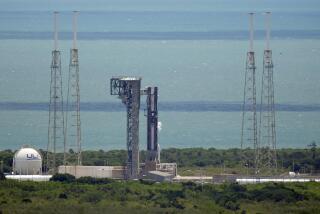Shuttle Ready for Delayed Liftoff Today : Highs in 60s Expected After Cold, Ice Forced 1-Day Postponement
- Share via
KENNEDY SPACE CENTER, Fla. — As ice that delayed launch of the space shuttle Discovery by 24 hours melted away Wednesday, NASA said all systems tied to the craft and its launching gear were ready for the postponed liftoff today.
The overnight low temperatures Wednesday night were not expected to hamper--as they did Tuesday night--the launch system’s firefighting equipment or to pose a threat to the orbiter’s heat-shielding tiles that protect it from the searing temperatures generated by its entry into the atmosphere as it returns to Earth.
By the three-hour launch period today--10:15 a.m. to 1:15 p.m. PST--the deep freeze was expected to be a thing of the past and temperatures could reach the low 60s.
Charles Redmond, a National Aeronautics and Space Administration spokesman, said that on Wednesday technicians repaired valves, pipes and nozzles broken or damaged by ice in the firefighting system on launch pad 39A. He said that Tuesday night’s subfreezing temperatures did not seem to have damaged the shuttle itself.
The crew--Navy Cmdr. Thomas K. Mattingly, Air Force Lt. Col. Loren J. Shriver, Air Force Maj. Ellison S. Onizuka, Marine Corps Lt. Col. James F. Buchli and Air Force Maj. Gary E. Payton--had a relaxed schedule, the space agency said.
Air Force Lt. Col. John Booth said the Pentagon will issue only a nine-minute warning that the actual liftoff is imminent to avoid giving the Soviet Union “adequate time to track” or take steps against the release of the spaceship’s super-sensitive cargo. This is to be the first flight of the shuttle devoted almost exclusively to a military mission.
There has been concern that with sufficient time, the Soviets could aim cameras from the ground or from satellites to photograph the cargo, reported to be a spy satellite intended to intercept Soviet signals and relay them to the United States.
But Jeffrey Richelson, an American University professor in Washington, D.C., and author of a book on the U.S. intelligence community, said that even if the Soviets have a satellite near the point at which the shuttle’s cargo is unloaded in space, a photograph might not reveal much more than is already known.
A picture could disclose the number of antennas and their diameters, he said in a telephone interview, but added: “It’s not clear they won’t be able to get those things from other sources--space telescopes and radar.”
The Soviets, he said, know the shuttle is being launched, and “they know what it’s going up with.”
“They want to track it as carefully as possible, but I don’t see what they’ll get from it,” he said.
Shuttle aficionados parked along the Indian River awaited the liftoff with interest.
“I figured there’d be more here, it being a secret launch,” said Lori West of Leesburg, Fla., who was spending the day camped on the west bank with her father, 23-month-old niece, long-haired dachshund and German shepherd.
She said she has missed only two or three launches since moving to Florida from California two years ago. On the other side of the country, she watched the spacecraft land at Edwards Air Force Base.
“I think the landings are a lot more fun than the takeoffs,” she said. “There are a lot more people for the landings and they’re more enthused to see it come back.”
During the day, a small knot of demonstrators held a quiet vigil at a gate to the Kennedy Space Center to protest military uses of space. They carried signs saying: “Weaponizing outer space is irresponsible,” and, “Keep the heavens undefiled.”
More to Read
Sign up for Essential California
The most important California stories and recommendations in your inbox every morning.
You may occasionally receive promotional content from the Los Angeles Times.













